1920 Dyer Harp Guitar - Model 7 Serial # 910
Back

Restoration project started on 8/6/08.
It's in rough shape.
The plastic bindings have shrunk and
are broken. Bindings are missing
from the fingerboard which is badly
chipped on the sides.
The soundboard has a large crack
about 3 inches right of the center line.
The bridge is badly split, the bridge
plate released creating a large dip in
the top just ahead of the bridge.
Several back braces are loose and
the back has a large split in it.
There is a blunt force trauma to the
bottom side of the lower bout just
right of center. This created two long
lateral cracks to form.
The guitar tuners are reverse
mounted Dobro style. One of the
harp tuners is missing but all of them
need replacement.
There is water damage on the inside
and outside of the harp arm that has
rotted away the edges of the sound
board that normally attaches to the
kerfing. The water created
significant staining to the interior of
the harp arm and body.
The finish on all surfaces is in very
bad shape.
It's in rough shape.
The plastic bindings have shrunk and
are broken. Bindings are missing
from the fingerboard which is badly
chipped on the sides.
The soundboard has a large crack
about 3 inches right of the center line.
The bridge is badly split, the bridge
plate released creating a large dip in
the top just ahead of the bridge.
Several back braces are loose and
the back has a large split in it.
There is a blunt force trauma to the
bottom side of the lower bout just
right of center. This created two long
lateral cracks to form.
The guitar tuners are reverse
mounted Dobro style. One of the
harp tuners is missing but all of them
need replacement.
There is water damage on the inside
and outside of the harp arm that has
rotted away the edges of the sound
board that normally attaches to the
kerfing. The water created
significant staining to the interior of
the harp arm and body.
The finish on all surfaces is in very
bad shape.


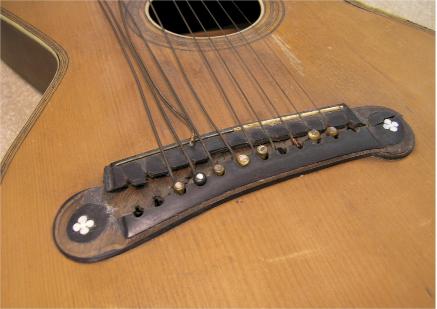
Well, you have to start somewhere.
We will remove, label, and bag all
hardware and any big pieces that fall
off.
We will remove, label, and bag all
hardware and any big pieces that fall
off.
A new bridge will be needed. The
pearl inlays here have been removed
and bagged.
pearl inlays here have been removed
and bagged.
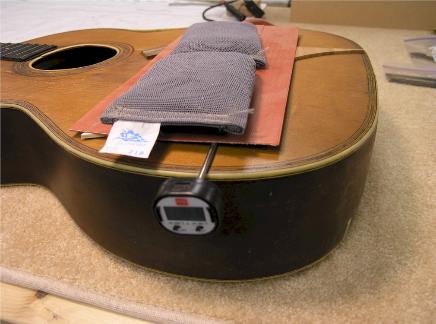
A small silicon heat blanket, normally
used for bending cutaways, is used
to heat the bridge pieces that didn't
fall off. Lead weight bags hold the
heat blanket is place.
Scrap wood is inserted under the
edges of the blanket to keep it off the
sound board finish. The blanket is
connected to my side bender safety
timer and temperature control. Let's
take it up to 220 degrees to loosen
the hide glue and help it off.
used for bending cutaways, is used
to heat the bridge pieces that didn't
fall off. Lead weight bags hold the
heat blanket is place.
Scrap wood is inserted under the
edges of the blanket to keep it off the
sound board finish. The blanket is
connected to my side bender safety
timer and temperature control. Let's
take it up to 220 degrees to loosen
the hide glue and help it off.
88 year old hide glue doesn't
give up easily, but eventually
the bridge comes off.
give up easily, but eventually
the bridge comes off.
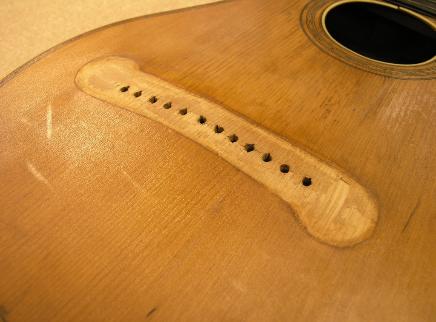
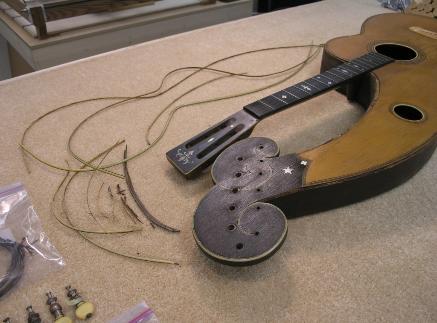
The majority of the binding is
now removed.
now removed.
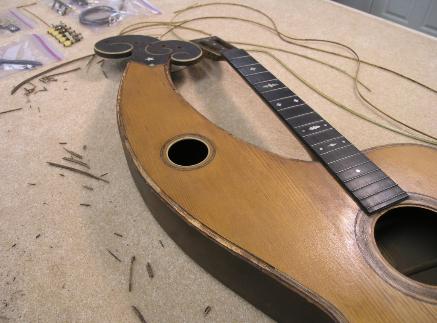
The normally beautiful black,
white, green and red purfling
that, in this case is all black, is
removed. Some purfling color
can be seen at the bottom of the
rosette.
white, green and red purfling
that, in this case is all black, is
removed. Some purfling color
can be seen at the bottom of the
rosette.
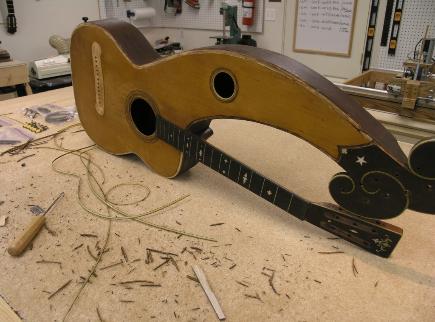
We will eventually remove the
top after steaming out the neck
and finger board.
top after steaming out the neck
and finger board.
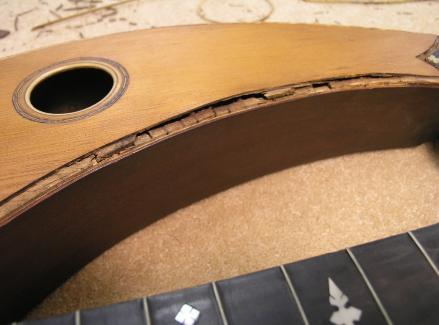
Water damage has rotted the
sound board edge that would
normally attach to the kerfing in
this area. This is one more nail in
the coffin for this top being
saved.
sound board edge that would
normally attach to the kerfing in
this area. This is one more nail in
the coffin for this top being
saved.
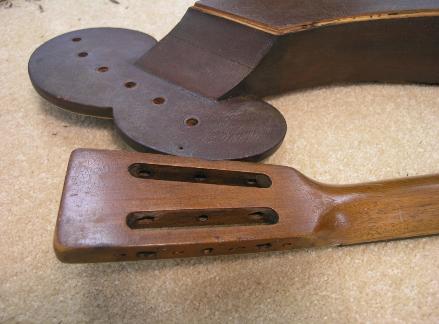
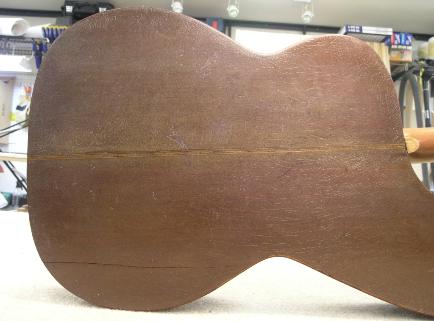
The right lower bout has a bad
crack and the center purfling
strip is badly dried out and
cracked. The center purfling
strip will be replaced.
crack and the center purfling
strip is badly dried out and
cracked. The center purfling
strip will be replaced.
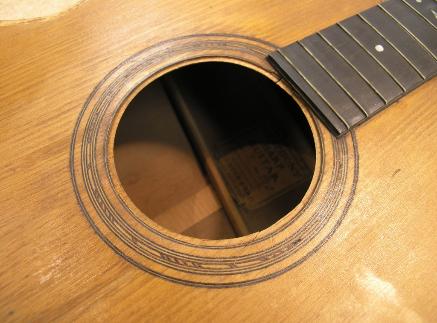
Internal inspection reveals two
large cracks in the top under the
fingerboard. The upper left
quadrant of the rosette is warped
and you can one of the cracks just
below the fingerboard. There are
no sound hole reinforcement
strips on the underside of the
sound board
Also in the photo you can see the
recessed ledge around the sound
hole. The ledge held a circular
ivroid strip that shrank causing
some additional small cracks
before it broke loose.
large cracks in the top under the
fingerboard. The upper left
quadrant of the rosette is warped
and you can one of the cracks just
below the fingerboard. There are
no sound hole reinforcement
strips on the underside of the
sound board
Also in the photo you can see the
recessed ledge around the sound
hole. The ledge held a circular
ivroid strip that shrank causing
some additional small cracks
before it broke loose.
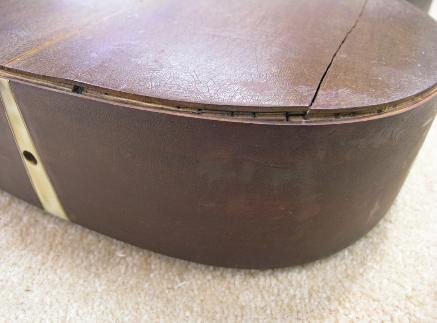
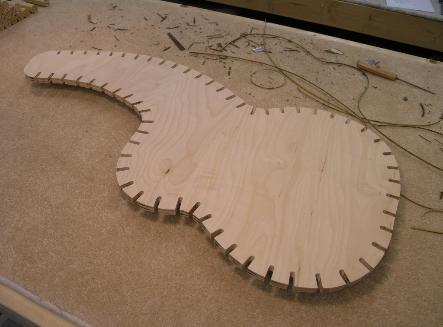
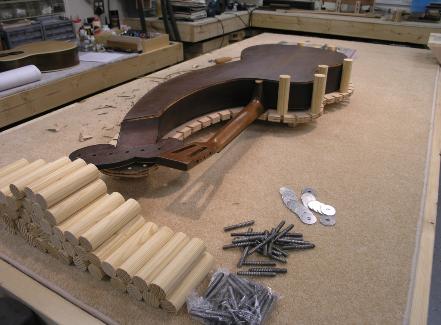
There are sixty supports ready for
assembly.
assembly.
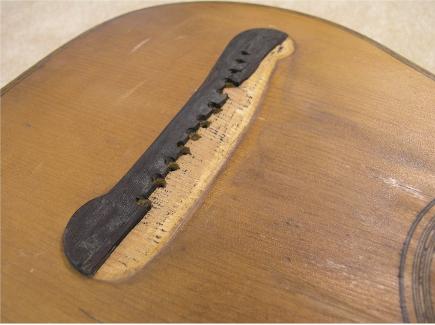
This is the remaining portion of the
bridge that held fast requiring heat to
remove. The forward edge of the
bridge outline is in a big dip.
The photo doesn't do the rise behind
the bridge and the dip in front
justice. It's a huge dip.
bridge that held fast requiring heat to
remove. The forward edge of the
bridge outline is in a big dip.
The photo doesn't do the rise behind
the bridge and the dip in front
justice. It's a huge dip.
The backs of the of peg heads
are in good shape.
are in good shape.
There is a deep crack in the
lower bout. The kerfing has
water damage and has come
loose from the back and side.
lower bout. The kerfing has
water damage and has come
loose from the back and side.
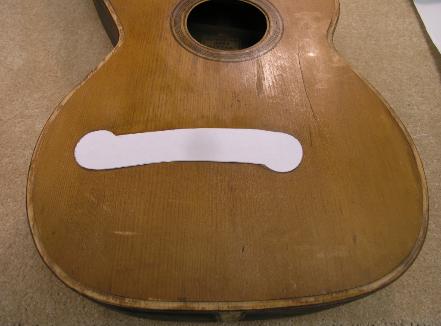
Fox style mold is being created.
The plan is to make this reversible
to accommodate face up or face
down positions. This will require
that the 1"x 2" stiffing and standoff
braces are removable and be
installed on either side of the deck.
The plan is to make this reversible
to accommodate face up or face
down positions. This will require
that the 1"x 2" stiffing and standoff
braces are removable and be
installed on either side of the deck.
I am creating a template for replacement
ebony bridge. This bridge is slightly larger
GAL drawings are very well done and will
be very helpful.
There is one important omission in the
GAL plans that should detail of how the
harp side peg head is attached to the arm.
The peg head is shown to attach in a
fashion that is not structurally sound. The
author of these plans did not have the
advantage of removing the top to see how
this was done. The peg head is made up
of alternating thicknesses of 1/16 and 3/16
layers rather than the uniform thicknesses
shown.
ebony bridge. This bridge is slightly larger
GAL drawings are very well done and will
be very helpful.
There is one important omission in the
GAL plans that should detail of how the
harp side peg head is attached to the arm.
The peg head is shown to attach in a
fashion that is not structurally sound. The
author of these plans did not have the
advantage of removing the top to see how
this was done. The peg head is made up
of alternating thicknesses of 1/16 and 3/16
layers rather than the uniform thicknesses
shown.
The fingerboard has the original
square frets. The original
ebony is very brittle and may not
survive the neck removal. The
goal will be to save it if possible.
square frets. The original
ebony is very brittle and may not
survive the neck removal. The
goal will be to save it if possible.
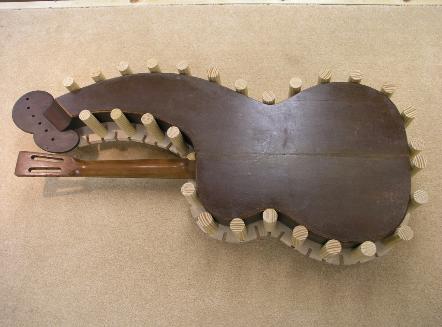
Approximately half of the supports
installed.
installed.
Time to pull the neck off.
Some extensive steaming and
wiggling appears to have gotten us
90% there. The lower part of the
finger board has been separated
from the top.
It's time to apply some direct force
with additional steaming.
I fabricated a harp guitar neck puller
to get the job done. A square steel
tube was used to provide enough
rigidity over the span of the harp
arm. This is normally aluminium bar
stock on a guitar neck puller and it
usually bent after normal use.
Some extensive steaming and
wiggling appears to have gotten us
90% there. The lower part of the
finger board has been separated
from the top.
It's time to apply some direct force
with additional steaming.
I fabricated a harp guitar neck puller
to get the job done. A square steel
tube was used to provide enough
rigidity over the span of the harp
arm. This is normally aluminium bar
stock on a guitar neck puller and it
usually bent after normal use.
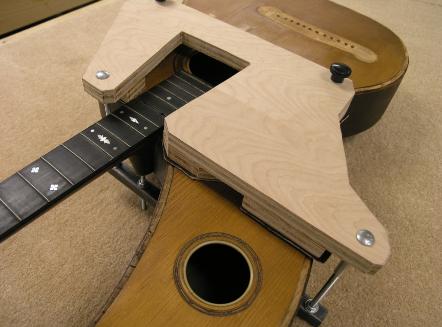
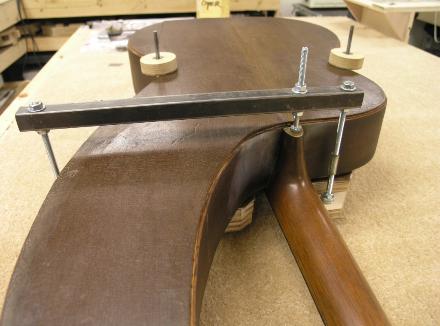
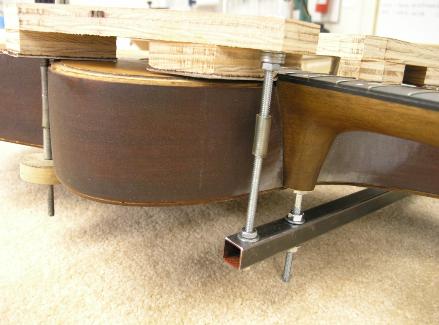
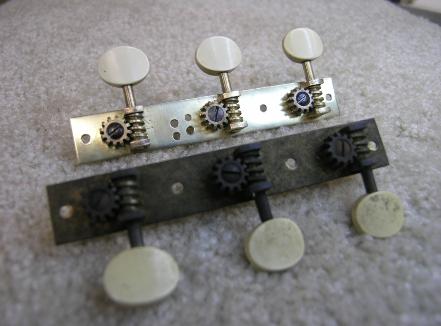
Time to clean up the tuners and see
what we have.
They cleaned up surprisingly well.
The extra pattern of holes you see
to the left of the center tuner is
used to support a brass tab that
secures the neck and harp arm
together.
You can see 88 years of crud in the
foreground.
what we have.
They cleaned up surprisingly well.
The extra pattern of holes you see
to the left of the center tuner is
used to support a brass tab that
secures the neck and harp arm
together.
You can see 88 years of crud in the
foreground.
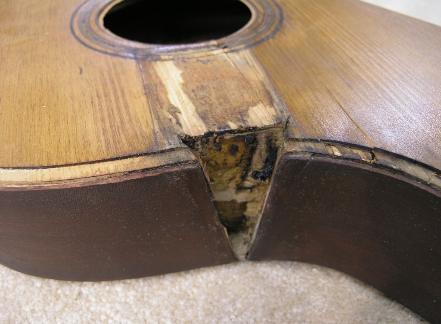
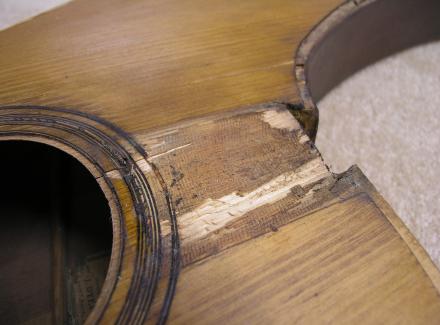
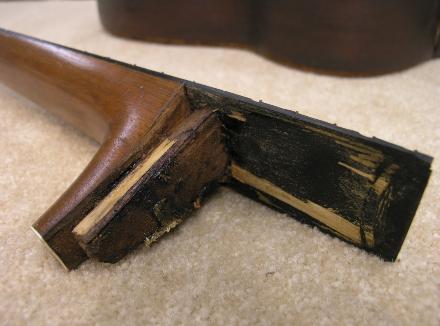
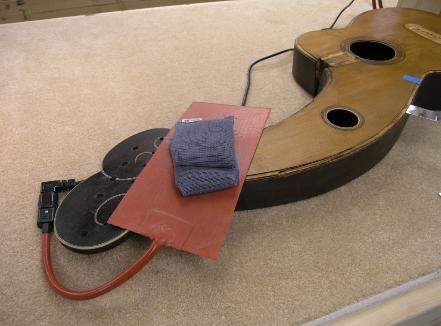
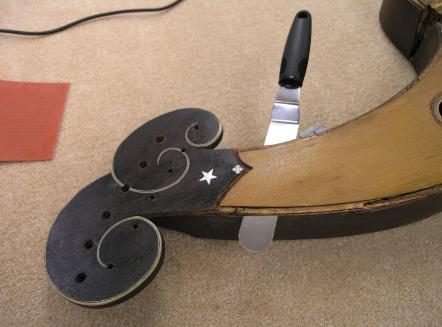
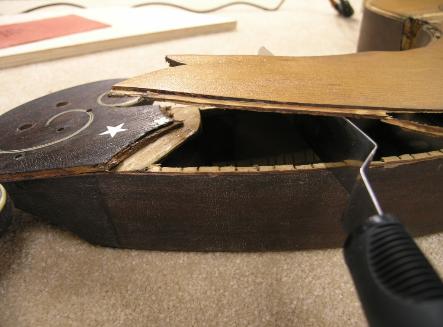
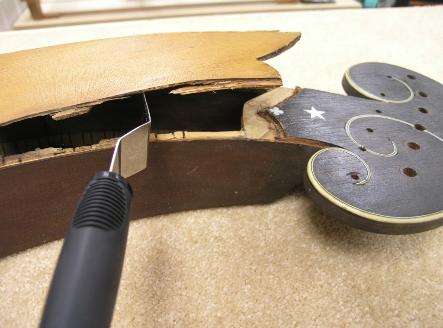
8/21/08 Neck removal
88 year old hide glue doesn't give in
without a fight.
88 year old hide glue doesn't give in
without a fight.
The top of the arm posed the
biggest challenge. More steam and
heat was needed to loosen the top
off of a mahogany block ledge
shown below.
biggest challenge. More steam and
heat was needed to loosen the top
off of a mahogany block ledge
shown below.
The pastry knife worked well for this
part.
part.
The good news from today is that
the finger board will be saved.
There is a huge multi-layered shim
about 3/16" or more thick attacked
to the left side of the dovetail.
The bottom fret board edges are
badly chipped and the shelf for the
binding will need to be restored.
the finger board will be saved.
There is a huge multi-layered shim
about 3/16" or more thick attacked
to the left side of the dovetail.
The bottom fret board edges are
badly chipped and the shelf for the
binding will need to be restored.
The technique for loosening the top
involves steam and heat applied to
the top edge and then separating
the top from the kerfing with a razor
blade. Most of the glue didn't
budge and I ended up using a razor
blade to cut through the kerfing.
involves steam and heat applied to
the top edge and then separating
the top from the kerfing with a razor
blade. Most of the glue didn't
budge and I ended up using a razor
blade to cut through the kerfing.
Internal inspection before removing
the neck revealed the two sound
board cracks under the fingerboard.
One of the cracks runs from the
rosette to dovetail and is a clean
break,
Note the saw blade marks, indicated
by arrows, from making the dovetail
slot. They didn't have electric
routers in 1920.
Removing the fingerboard also
revealed the original purling colors
at the top of the rosette.
the neck revealed the two sound
board cracks under the fingerboard.
One of the cracks runs from the
rosette to dovetail and is a clean
break,
Note the saw blade marks, indicated
by arrows, from making the dovetail
slot. They didn't have electric
routers in 1920.
Removing the fingerboard also
revealed the original purling colors
at the top of the rosette.
^
^
A little more heat and poking pops it
free. All the hide glue is stuck to
the underside of the top.
free. All the hide glue is stuck to
the underside of the top.
It's time to rework the mold and
secure the body before continuing
with the removal of the sound board.
secure the body before continuing
with the removal of the sound board.
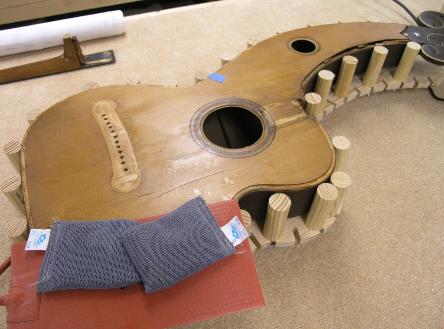
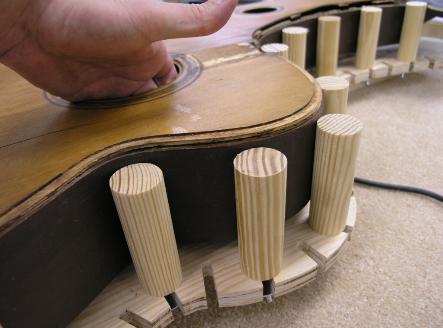
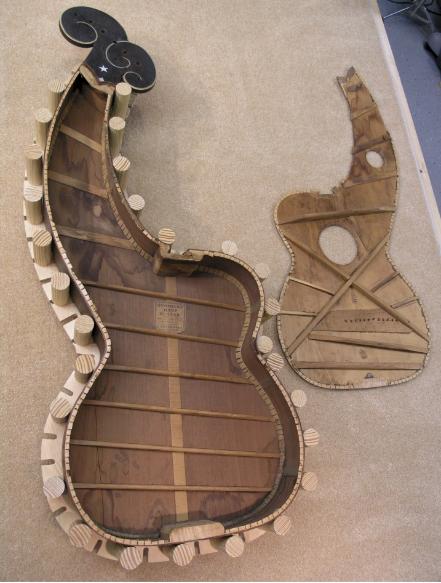
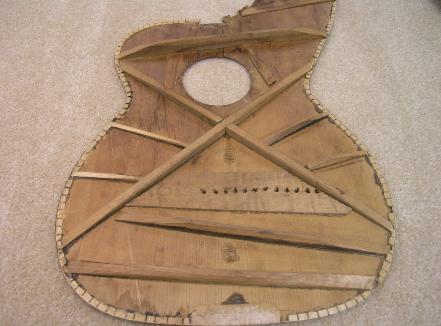
The quality of the bracing is a huge
disappointment. All of the glue in
the joints is in the process of
crystallizing and flaking off.
Later I scraped the area below the
bridge plate and between the two
braces running left and right. The
wood used for the sound board
has a wide grain and resembles
Adirondack spruce. There is no
narrow grain at all.
Also, the sound board is not book
matched and the grain on each
side is not parallel to one another.
The grain tilts slightly toward the
middle.
disappointment. All of the glue in
the joints is in the process of
crystallizing and flaking off.
Later I scraped the area below the
bridge plate and between the two
braces running left and right. The
wood used for the sound board
has a wide grain and resembles
Adirondack spruce. There is no
narrow grain at all.
Also, the sound board is not book
matched and the grain on each
side is not parallel to one another.
The grain tilts slightly toward the
middle.
Side cracks and additional water
damage.
damage.
Some of the water damage is
evident. Much of the kerfing in
these areas is rotted. The rot
compromised the structural
integrity of all glue joints it came in
contact with.
evident. Much of the kerfing in
these areas is rotted. The rot
compromised the structural
integrity of all glue joints it came in
contact with.
Remember scalloped tone bracing
had not been invented yet. Let's
call these tone planks.
The irregular bridge plate shape is
typical of others I have seen.
It looks like all of the bracing was
shaped with a pocket knife.
had not been invented yet. Let's
call these tone planks.
The irregular bridge plate shape is
typical of others I have seen.
It looks like all of the bracing was
shaped with a pocket knife.
The top is now off. After significant
clean up this is what we have.
Note the mold has been reversed for
face up work.
clean up this is what we have.
Note the mold has been reversed for
face up work.
It's starting to lift, almost there.
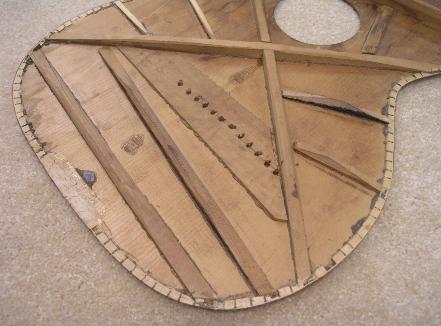
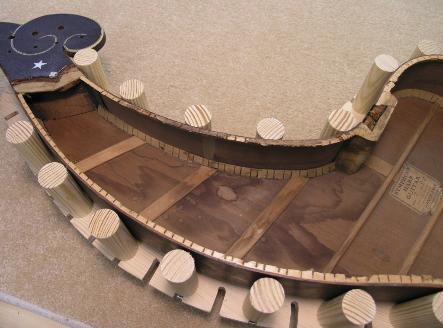
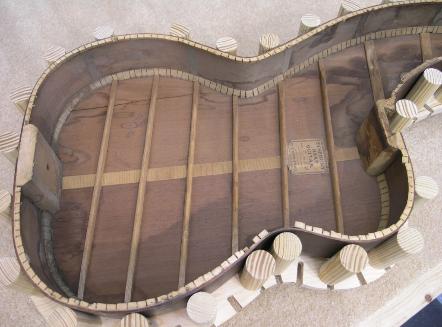
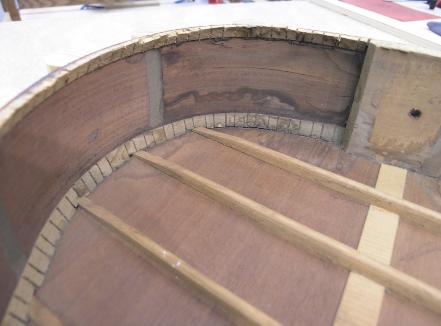
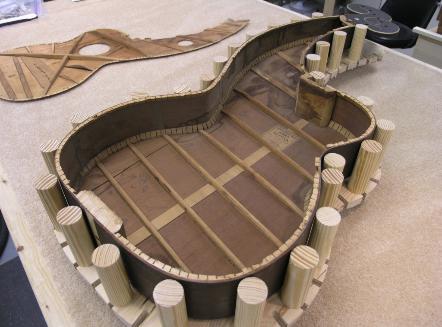
The water damage caused a
number of problems. Where ever
stains appear, the glue joints have
let go or no longer have structural
integrity.
The back kerfing in the upper left
has released along with the back
braces in this area. This
contributed to the large crack
shown in the same area.
number of problems. Where ever
stains appear, the glue joints have
let go or no longer have structural
integrity.
The back kerfing in the upper left
has released along with the back
braces in this area. This
contributed to the large crack
shown in the same area.
OK, time to get a new red spruce
top.
top.
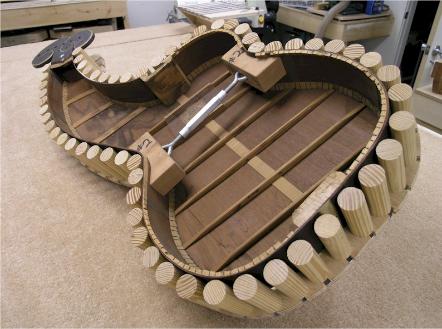
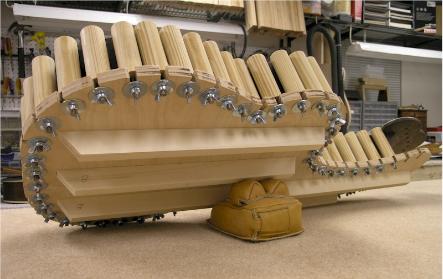
Full mold and bracing in place.
Beginning to remove kerfing in the
harp arm.
Beginning to remove kerfing in the
harp arm.
View from below.
^
^
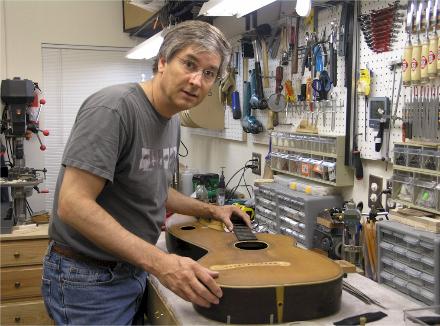
Call the E.R. and tell them we're coming.
I will need a fifth of Jack Daniels, lots of
steam, a pastry knife, a chainsaw, and a
lumber jack standing by.
I will need a fifth of Jack Daniels, lots of
steam, a pastry knife, a chainsaw, and a
lumber jack standing by.
Bottom and side views.
^
^
harp guitar, harp-guitar, harpguitar,
guitar-harp, compound guitar,
one-arm guitar, doubleneck guitar,
double neck guitar, one-armed guitar,
hollow arm guitar, hollow-armed guitar,
harp guitars, harp-guitars,
harpguitars.net, harpguitars.com,
harp guitar luthier, harpguitars,
guitar-harps, bass guitars,
doubleneck guitars, double neck guitars,
one-armed guitars, Larson Brothers,
Dyer, Dyer Harp Guitar, Harp Guitar Cutaway, Harp Guitar
builder, Custom harp guitar, Harp guitar luthier,
Harp guitar for sale, Buy harp guitar
guitar-harp, compound guitar,
one-arm guitar, doubleneck guitar,
double neck guitar, one-armed guitar,
hollow arm guitar, hollow-armed guitar,
harp guitars, harp-guitars,
harpguitars.net, harpguitars.com,
harp guitar luthier, harpguitars,
guitar-harps, bass guitars,
doubleneck guitars, double neck guitars,
one-armed guitars, Larson Brothers,
Dyer, Dyer Harp Guitar, Harp Guitar Cutaway, Harp Guitar
builder, Custom harp guitar, Harp guitar luthier,
Harp guitar for sale, Buy harp guitar